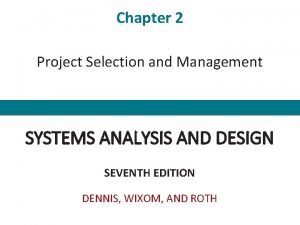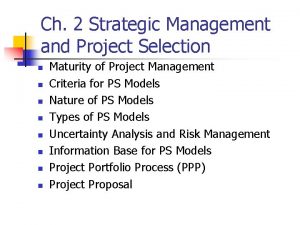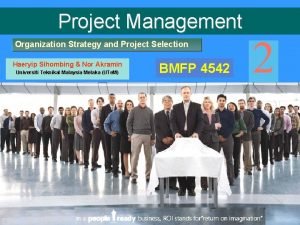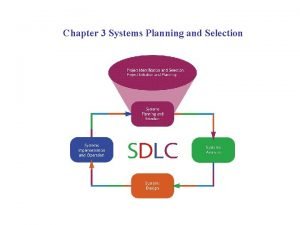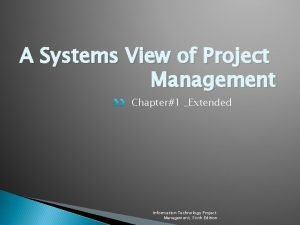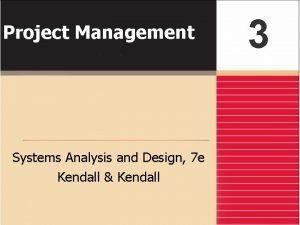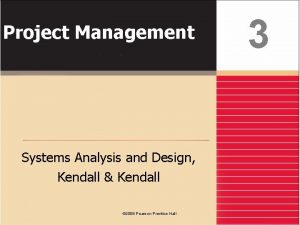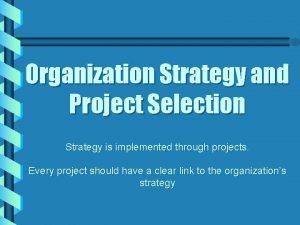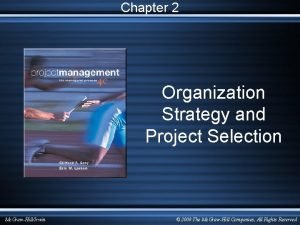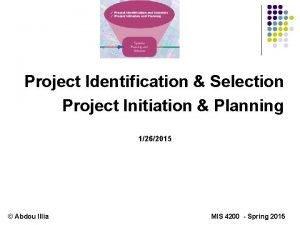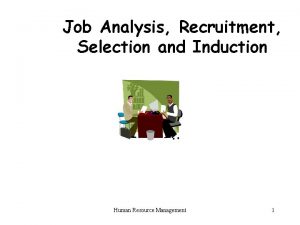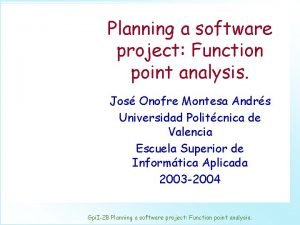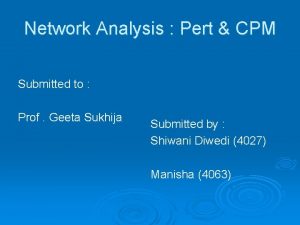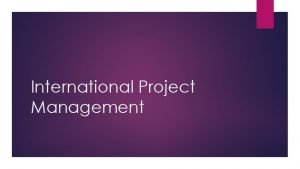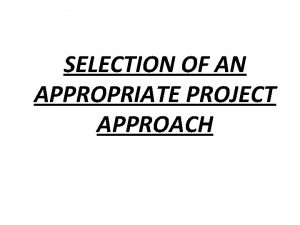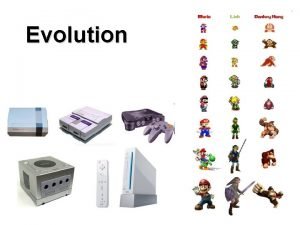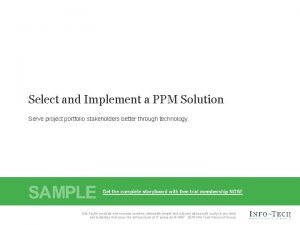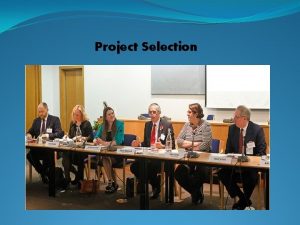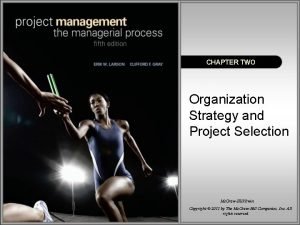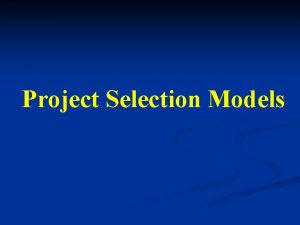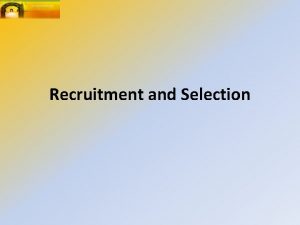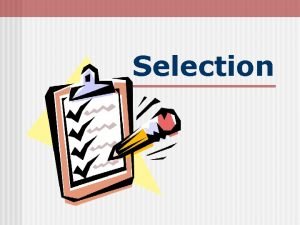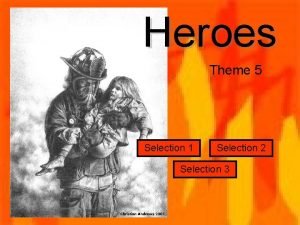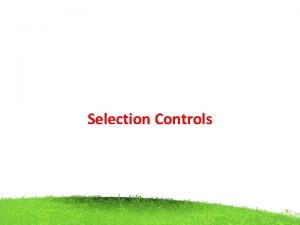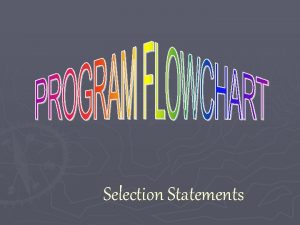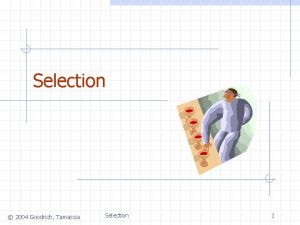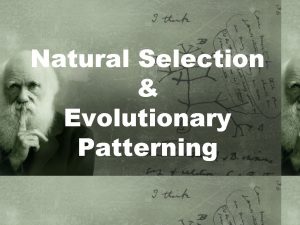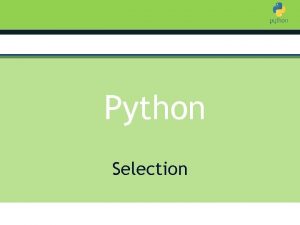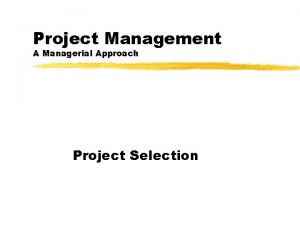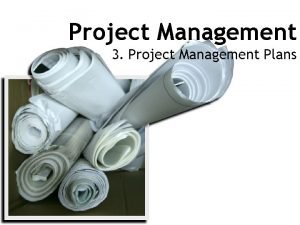Chapter 2 Project Selection and Management SYSTEMS ANALYSIS
















































- Slides: 48

Chapter 2 Project Selection and Management SYSTEMS ANALYSIS AND DESIGN SEVENTH EDITION DENNIS, WIXOM, AND ROTH

Learning Objectives • Explain how projects are selected in some organizations. • Describe various approaches to the SDLC that can be used to structure a development project. • Explain how to select a project methodology based on project characteristics. • Become familiar with project estimation. • Be able to create a project work plan. • Describe project staffing issues and concerns. • Describe and apply techniques to coordinate and manage the project. • Explain how to manage risk on the project. Copyright © 2019 John Wiley & Sons, Inc. 2

Project Selection HOW SPECIFIC PROJECTS ARE CHOSEN Copyright © 2019 John Wiley & Sons, Inc. 3

Project Selection Issues (1 of 2) • Ways to Characterize Projects • • Size Cost Purpose Length Risk Scope Economic Value Copyright © 2019 John Wiley & Sons, Inc. 4

Project Selection Issues (2 of 2) • Approval committee uses the system request and the feasibility study Project portfolio perspective – how does the project fit within the entire portfolio of projects? • Trade-offs needed: select projects to form a balanced project portfolio • Viable projects may be rejected or deferred due to project portfolio issues. • Copyright © 2019 John Wiley & Sons, Inc. 5

Project Portfolio Management • PPM software collects and manages information about all projects – on-going and awaiting approval. • Companies stay up to date on projects and adapt to changing conditions. • Features: project prioritization, employee allocation, real-time project monitoring, flagging cost and time variances, monitoring economic feasibility. Copyright © 2019 John Wiley & Sons, Inc. 6

Creating the Project Plan • Upon project approval, the project manager must: Select the best project methodology • Develop a project work plan • Establish a staffing plan • Create ways to coordinate and control the project • Copyright © 2019 John Wiley & Sons, Inc. 7

Creating the Project Plan DEVELOPING A PLAN FOR A SUCCESSFUL RESULT Copyright © 2019 John Wiley & Sons, Inc. 8

Selecting a Project Methodology • Methodology: A formalized approach to implementing the SDLC • A series of steps to perform and deliverables to produce • Methodology Sources Internally developed by organizations • Consulting firms • Software vendors • Government agencies • Copyright © 2019 John Wiley & Sons, Inc. 9

Selecting a Project Methodology - Issues • These factors influence the best choice: • • • Clarity of User Requirements Familiarity with Technology System Complexity System Reliability Time Frame Schedule Visibility Copyright © 2019 John Wiley & Sons, Inc. 10

Structured Systems Development • Based upon SDLC • Assumes a project phase is complete before moving to the next phase Waterfall Development • Parallel Development • V-model • • Goal – doing each phase thoroughly before moving forward ensures correct and high-quality outcomes Copyright © 2019 John Wiley & Sons, Inc. 11

Waterfall Development Methodology • Move from phase to phase • Emphasis on deliverables from one phase flowing into the next phase Copyright © 2019 John Wiley & Sons, Inc. 12

Waterfall Methodology Assessment STRENGTHS • System requirements identified long before construction begins • Requirements are “frozen” as project proceeds – no moving targets allowed WEAKNESSES • Must wait a long time before there is “visible” evidence of the new system • Takes a long time from start to finish Copyright © 2019 John Wiley & Sons, Inc. 13

Parallel Development Methodology • Subdivide the project into subprojects that can be worked on at the same time. • Reduce the overall project length Copyright © 2019 John Wiley & Sons, Inc. 14

Parallel Methodology Assessment STRENGTHS • Reduces overall project time (compared to Waterfall) • Reduces the need for rework; with shorter time frame, less chance of requirements changing WEAKNESSES • Creating subprojects requires careful design decisions • Integrating subprojects at the end can be complex and difficult Copyright © 2019 John Wiley & Sons, Inc. 15

V-Model Development Methodology • Emphasizes system quality through text plan development Copyright © 2019 John Wiley & Sons, Inc. 16

V-Model Methodology Assessment STRENGTHS • Simple and straightforward • Quality improves through the emphasis on testing • Including Quality Assurance expertise early in the project strengthens system quality WEAKNESSES • Rigid • Difficult to use in a dynamic business environment Copyright © 2019 John Wiley & Sons, Inc. 17

Rapid Application Development • Incorporates special techniques and tools CASE tools • JAD sessions • Visual programming languages • Code generators • • Goal – get some portion of system developed quickly and into the users’ hands Copyright © 2019 John Wiley & Sons, Inc. 18

Three RAD Approaches • Iterative development • A series of versions developed sequentially • System Prototyping • Create prototype (model) of system and “grow” it into the final system • Throw-away prototyping Prototype alternative designs in an experimental way • Build system following prototype design but discard the actual prototype • Copyright © 2019 John Wiley & Sons, Inc. 19

Iterative Development Methodology • RAD approach • Develop system in series of versions Copyright © 2019 John Wiley & Sons, Inc. 20

Iterative Development Methodology Assessment STRENGTHS • Users get a system to use quickly • Users identify additional needs for later versions based on real experiences with current version WEAKNESSES • Users faced with using an incomplete system for a time • Users must be patient and wait for fullyfunctional system Copyright © 2019 John Wiley & Sons, Inc. 21

System Prototyping Development Methodology • RAD approach • Create a rough version of system quickly and “grow” it into final system with repetitive refinement Copyright © 2019 John Wiley & Sons, Inc. 22

System Prototyping Methodology Assessment STRENGTHS • Users get to work with prototype very quickly • Feedback cycles let users identify changes and refine real requirements WEAKNESSES • Superficial analysis may cause problems • Initial design decisions may be poor • Overlooked features may be hard to add later Copyright © 2019 John Wiley & Sons, Inc. 23

Throwaway Prototyping Development Methodology • R A D approach • Adds emphasis on experimenting with design options before design is finalized • Design options are thrown-away, but learning from them is factored into final design Copyright © 2019 John Wiley & Sons, Inc. 24

Throwaway Prototyping Methodology Assessment STRENGTHS • Uncertainty is minimized • Important issues are understood before building the final system WEAKNESSES • May take longer (compared to system prototyping) Copyright © 2019 John Wiley & Sons, Inc. 25

Agile Development Methodology • Extreme Programming (XP), Scrum, and others • Focus on short cycles that produce a complete software product • Highly adaptable in dynamic environments Copyright © 2019 John Wiley & Sons, Inc. 26

Agile Methodologies Assessment STRENGTHS • Fast delivery of results • Works well in projects with undefined or changing requirements WEAKNESSES • Requires discipline • Significant user involvement is essential • Initial high learning curve • Works best in smaller projects Copyright © 2019 John Wiley & Sons, Inc. 27

Selection Summary Ability to develop systems Waterfall Parallel V-Model Iterative System Prototyping Throwaway Prototyping Agile Development With unclear user requirements Poor Good Excellent With unfamiliar technology Poor Good Poor Excellent Poor That are complex Good Poor Excellent Poor That are reliable Good Excellent Good Poor Excellent Good With a short time schedule Poor Good Poor Excellent Good Excellent With schedule visibility Poor Excellent Good Copyright © 2019 John Wiley & Sons, Inc. 28

Project Management Tasks PREPARING TO LAUNCH THE PROJECT Copyright © 2019 John Wiley & Sons, Inc. 29

Project Manager’s Balancing Act Project Management involves making tradeoffs… Modifying one element requires adjusting the others Copyright © 2019 John Wiley & Sons, Inc. 30

Project Estimation • The process of assigning projected values for time and effort • Sources of estimates Methodology in use • Actual previous projects • Experienced developers • • Estimates begin as a range and become more specific as the project progresses Industry standards • Function point estimation (Appendix 2 A) • Copyright © 2019 John Wiley & Sons, Inc. 31

Project Estimates Using Industry Standard Percentages INDUSTRY STANDARD PERCENTAGES Planning Analysis Design Implementation 35 30 Typical industry 15 standards for business applications (%) 20 Estimates Actual: based on actual 4 figures for the first stage of SD LC* (personmonths) Estimated: 5. 33 9. 33 8 EXAMPLE IF 4 months are required for Planning, then 15% X = 4, where X = overall length of project X = 26. 66 months for entire project *SDLC, systems development life cycle. Therefore: • Planning (15%): 4 months • Analysis (20%): 5. 33 months • Design (35%): 9. 33 months • Implementation (30%): 8 months • Copyright © 2019 John Wiley & Sons, Inc. Total Project Length: 26. 66 months 32

Identifying Tasks • Use established guidelines – existing methodologies • Use analogies – model previous projects’ task lists • Top-down approach – break high level tasks into smaller, detailed tasks • Organize into work breakdown structure Copyright © 2019 John Wiley & Sons, Inc. 33

Example – Determining Tasks using Top-down Approach • Grade programming assignments 1. Create grading plan A. Develop grading rubric B. Develop test plan, test data, and check figures 2. Prepare programming projects for grading A. Download submitted projects B. For all projects, extract zipped files 3. For all projects, A. Administer test plan Check performance • Verify results • B. Check code for required elements and standards C. Apply rubric and determine final score. Copyright © 2019 John Wiley & Sons, Inc. 34

Typical Workplan Entry Task Information Example Name of the task Perform economic feasibility Start date Jan 5, 2019 Completion date Jan 19, 2019 Person assigned to the task Project sponsor Mary Smith Deliverable(s) Cost—benefit analysis Completion status Complete Priority High Resources needed Spreadsheet software Estimated time 16 hours Actual time 14. 5 hours Copyright © 2019 John Wiley & Sons, Inc. 35

Project Work Plan Copyright © 2019 John Wiley & Sons, Inc. 36

Staffing Considerations • Match skills to project needs whenever possible • Consider technical skills and interpersonal skills All IS work is done in teams • Technical skills are not sufficient – need to be able to work with others • Use training and outside sources (consultants, vendor support) when skills are not readily available • • Staffing levels will change over a project’s lifetime • Adding staff adds overhead; not always productive Copyright © 2019 John Wiley & Sons, Inc. 37

Motivation (1 of 2) • Use monetary rewards cautiously • Use intrinsic rewards • • • Recognition Achievement The work itself Responsibility Advancement Chance to learn new skills Copyright © 2019 John Wiley & Sons, Inc. 38

Motivation (2 of 2) • Consider the “de-motivators” … DO NOT • • • Assign unrealistic deadlines Ignore good efforts Accept a low-quality product Give everyone on the project the same raise Make an important decision without the team’s input Maintain poor working conditions Copyright © 2019 John Wiley & Sons, Inc. 39

Assuring Group Performance • Make sure team understands the project and its goals • Establish operating procedures (Project Charter) Availability • Status reporting • Meetings • • Ensure that team members get to know each other • Establish methods for dealing with problems Copyright © 2019 John Wiley & Sons, Inc. 40

Project Estimates Require Refinement Typical Margins of Error for Well. Prepared Estimate Cost (%) Typical Margins of Error for Well. Prepared Estimate Schedule Time (%) Phase Deliverable Planning phase System request 400 60 Project plan 100 25 Analysis phase System proposal 50 15 Design phase System specifications 25 10 Source: Barry W. Boehm and colleagues, “Cost Models for Future Software Life Cycle Processes: COCOMO 2. 0, ” in J. D. Arthur and S. M. Henry (eds. ) Annals of Software Engineering Special Volume on Software Process and Product Measurement, Amsterdam: J. C. Baltzer AG Science Publishers, 19 95. • Even projects with high-quality estimates will need refinement • Project managers must adjust estimated time throughout the project Copyright © 2019 John Wiley & Sons, Inc. 41

Managing Scope • Beware of scope creep • Use JAD and prototyping to minimize scope creep pressure • Implement formal change approval process • Defer additional requirements as future system enhancements a Copyright © 2019 John Wiley & Sons, Inc. 42

Timeboxing • Time estimating techniques may reveal that the project requires more time than we have available • Timeboxing helps in these situations • • • Set a tight but realistic deadline. Identify core, essential functional requirements Team limits focus just to essential functions High quality is stressed Other functions will be added later Repeat to add refinements and enhancements Copyright © 2019 John Wiley & Sons, Inc. 43

When a Target Date is Missed… • Don’t assume you can catch up • The ONLY situation in which you can make up time is when: • The remainder of the project is simpler than the part you fell behind on, and • The remainder of the project is simpler than you expected when the original estimates were made. • Evaluate the complexity of the remainder of the project to determine the correct schedule adjustment. • Adding people is not always the right way to handle schedule slippages. Copyright © 2019 John Wiley & Sons, Inc. 44

After reading and studying this chapter, you should be able to: (1 of 3) • Explain how the practice of project portfolio management may influence the selection of IS projects. • Discuss the skills needed to be a successful systems analyst. • List and explain the project characteristics that affect the selection of a project methodology. • List and explain three methodologies that are based on the waterfall concept. • List and explain three methodologies that are based on RAD. Copyright © 2019 John Wiley & Sons, Inc. 45

After reading and studying this chapter, you should be able to: (2 of 3) • List and explain two Agile methodologies. • For each methodology included in the chapter, be able to summarize the project characteristics that make that methodology the best choice and the poorest choice. Be able to explain why. • Discuss ways to estimate the time frame for a project. • Discuss the purpose and content of the project work plan. • Discuss the three main tasks involved when staffing a project. • Describe various ways to influence the motivation of project team members. Copyright © 2019 John Wiley & Sons, Inc. 46

After reading and studying this chapter, you should be able to: (3 of 3) • Explain the purpose and content of a project charter. • Describe the role of CASE tools in coordinating the project. • Describe the value of standards to the project team. • Discuss the project manager’s balancing act involving size, time, and cost. • Describe how scope creep affects a project. • Discuss the technique of timeboxing and how it affects a project team. Copyright © 2019 John Wiley & Sons, Inc. 47

Copyright © 2019 John Wiley & Sons, Inc. All rights reserved. Reproduction or translation of this work beyond that permitted in Section 117 of the 1976 United States Act without the express written permission of the copyright owner is unlawful. Request for further information should be addressed to the Permissions Department, John Wiley & Sons, Inc. The purchaser may make back-up copies for his/her own use only and not for distribution or resale. The Publisher assumes no responsibility for errors, omissions, or damages, caused by the use of these programs or from the use of the information contained herein. Copyright © 2019 John Wiley & Sons, Inc. 48
 Selection project chap
Selection project chap Selection project 3
Selection project 3 Unweighted 0-1 factor model
Unweighted 0-1 factor model Checklist model project management
Checklist model project management Strategic management and project selection
Strategic management and project selection Traditional vs modern project management
Traditional vs modern project management Two way selection and multiway selection in c
Two way selection and multiway selection in c Multiway selection in c
Multiway selection in c Mass selection and pure line selection
Mass selection and pure line selection Project screening matrix
Project screening matrix Balancing selection vs stabilizing selection
Balancing selection vs stabilizing selection Similarities
Similarities K selection r selection
K selection r selection Natural selection vs artificial selection
Natural selection vs artificial selection Artificial selection vs natural selection
Artificial selection vs natural selection Disruptive selevtion
Disruptive selevtion Logistic model of population growth
Logistic model of population growth Natural selection vs artificial selection
Natural selection vs artificial selection Systems planning and selection
Systems planning and selection Systems view of project management
Systems view of project management Ms project earned value analysis
Ms project earned value analysis Security analysis and portfolio management project
Security analysis and portfolio management project Security analysis and portfolio management project
Security analysis and portfolio management project Project management in system analysis and design
Project management in system analysis and design It analysis design and project management
It analysis design and project management Strategy is implemented through projects
Strategy is implemented through projects Project portfolio matrix dimensions
Project portfolio matrix dimensions Potential development projects can be identified by
Potential development projects can be identified by Project identification and selection
Project identification and selection The role of project management in achieving project success
The role of project management in achieving project success Modern process transitions in spm
Modern process transitions in spm Reasons for reducing project duration
Reasons for reducing project duration Introduction to project management kathy schwalbe
Introduction to project management kathy schwalbe Project evaluation in software project management
Project evaluation in software project management Types of project audit in project management
Types of project audit in project management Microsoft project scrum template
Microsoft project scrum template Project termination types
Project termination types Job analysis recruitment and selection
Job analysis recruitment and selection Chapter 4 energy analysis of closed systems
Chapter 4 energy analysis of closed systems Decision support systems and intelligent systems
Decision support systems and intelligent systems Function point in software project management
Function point in software project management 3+6×(5+4)÷3-7
3+6×(5+4)÷3-7 Introductory video
Introductory video Dow theory
Dow theory Selection of an appropriate project report
Selection of an appropriate project report Analougous
Analougous How to select a ppm solution
How to select a ppm solution Project selection meaning
Project selection meaning Selection project mc
Selection project mc
